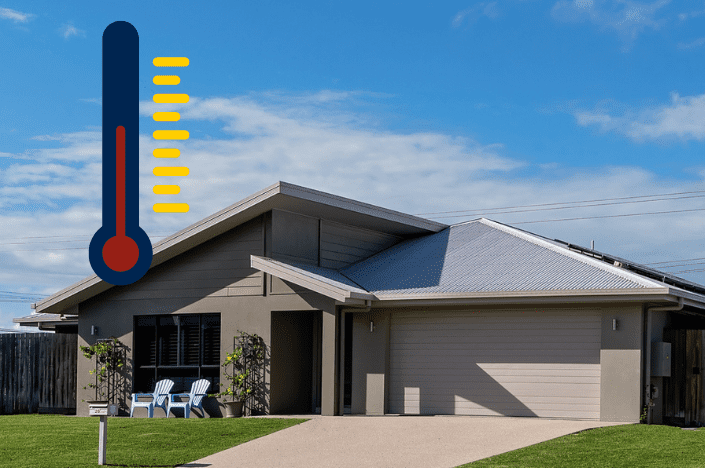As you’ve been getting home from work lately, you’ve probably realized that your home’s once vibrant color is starting to look a little shabby. You are itching for an opportunity to get some fresh paint on ye ol’ home. But the heat! It’s been too hot outside lately to even consider painting it. Then you start thinking, “Maybe this is a good time to paint my home.” What exactly is the best temperature to paint the exterior of your house?
Finding the best temperature to paint your home’s exterior is fundamental for a quality, work of art kind of a job. So, when is it too hot or too cold to paint your home’s exterior?
These are a couple of house painting questions many homeowners ask themselves throughout the fall and mid year months.
Whether you are tackling the project or are hiring someone, these are a few things to consider on when painting the exterior of your house.

Which Paints Are Best?
Like any big home improvement decision, you will want to do some studying to determine the best paint decision for your home. Prior to picking your favorite paint color, you’ll want to understand what sort of paint your home really needs. Some paints dry faster than others, and some paints can endure the weather changes a bit better than others. Both of these are big factors to consider when thinking about time and temperature, as Colorado can sometimes be unpredictable, weather-wise.
Latex Paint
Latex paint has been a common choice of paint since the 1950s. Latex paint is often water-based which is good for the environment and yourself.
Latex paint is strong, mildew-resistant, and adequately thick enough to usually get the job done in one coat. Latex paint is easier to apply and has a much quicker drying time when compared to other paints.
Acrylic Paint
Acrylic paint can withstand direct sunlight far better than latex. The chemicals used in the paint gives more elasticity which allows acrylic paint to expand and contract as temperatures change.
While latex paint is water-based, acrylic is chemical-based which makes it harder to fix if a mistake arises.
Oil-Based Paint
Oil-based paint dries to a smooth, hard surface that stands up well to the Colorado weather. Oil-based paints are made from a strong resin which makes the paint incredibly durable to sun damage.
The downside to using oil-based paints is that they are more likely to fade or crack than acrylic and latex paints. Oil-based paints are not widely used today because of the hazardous fumes it emits when wet.
Oil-based paints are also very difficult to get clean once spilled on something it wasn’t supposed to.

The Effects of Temperature On Paint
The problem with outdoor temperatures being either too high or too low is that your paint might not bind to other materials properly.
Heat and Warm Temperatures
Direct sunlight and heat can affect paint drying and curing. Hot temperatures mean the paint dries almost instantly when applied.
Latex paint is water-based and needs sufficient time for the water to naturally evaporate for the paint to cure. When the paint doesn’t cure properly, it can lead to bubbling, cracking, or peeling of your paint once it dries.
Cold/Freezing Temperatures
Painting your house at lower temperatures will greatly impact your paint’s drying time and overall consistency.
So, if you are trying to brave the cold and paint your house, don’t paint outside when it’s below 35 degrees Fahrenheit. If done at lower temperatures, it will cause your paint to cure incorrectly. The results may leave you with ugly bumps/bubbles in your paint when spring arrives. Worse yet, it can lower the lifespan of your paint job.
Painting in Wet Conditions
Colorado is infamous for its unconventional and eccentric weather patterns. It can rain, snow, or hail just about out of nowhere sometimes.
As a general rule, paint should only be applied to dry surfaces. So even after the rain, snow, or hail; you need to allow plenty of time for the exterior of your home to dry before applying any paint. This allows the paint to not get washed off.
If there is any precipitation in the forecast, you’ll need to hold off on painting. Typically, you’ll need 4-8 hours of dry time (minimum) after it rains for things to completely dry out.

The Best Temperature To Paint The Exterior of Your House
In Colorado, the best time of year to paint your house is between late April and early October. Temperatures between 50-70 degrees Fahrenheit are going to be the most optimal. That being said, there is some leeway on temperature, with about 10 degrees on both sides of the spectrum.
Although there are great days and temperatures to paint the exterior of your house in just about every month of the year, the window of opportunity really begins in late April. This will allow you to avoid most of the precipitation associated with our spring season.
The mid-summer is another one of the best times as far as temperature goes to paint your home in Colorado. With low precipitation, warm temperatures, and plenty of sunshine, the season allows your paint to dry and cure as it was meant to.
The window to paint the exterior of your home closes in early October. After this time of year (for the most part), the temperature drops too low for painting.































